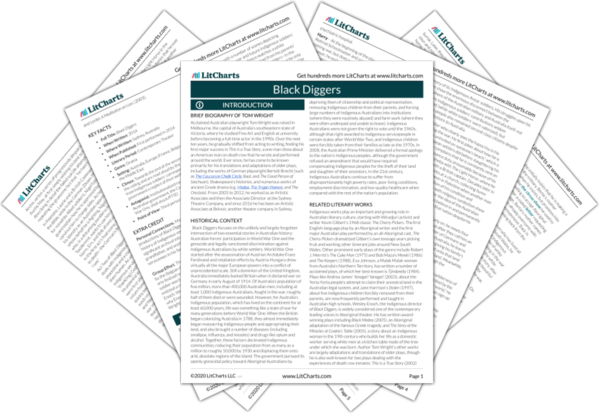Australian Nationhood and Indigenous Dispossession
Black Diggers tells the tale of a decision at once contradictory and extraordinary: that of thousands of Indigenous Australians to fight in World War I for the same white settler colonial government that massacred them and stole their lands. While the play draws clear parallels between colonialism and the war, it also shows how Indigenous people saw the war as an opportunity to overcome the wounds of colonialism—to join the Australian nation rather than staying…
read analysis of Australian Nationhood and Indigenous DispossessionRacism
The Aboriginal soldiers portrayed in Black Diggers suffer discrimination not only from the Australian state—which appropriates their land before and after the war, deprives them of wages and promised veterans’ benefits, and denies them respect as the original inhabitants of Australia and dedicated fighters in World War One—but also from other people they encounter, Australians and non-Australians alike, in their everyday lives. This discrimination is founded on an open and flagrant racism that justifies itself…
read analysis of RacismWar, Violence, and Shell Shock
Like many war stories, Black Diggers confronts the acts of senseless and extreme violence that forever transform its subjects’ lives, leaving them traumatized and stuck in the past once they turn from soldiers into veterans. While World War I was infamous for introducing the world to shell shock—the condition of extreme, prolonged agony now officially known as Post-Traumatic Stress Disorder—the Indigenous soldiers profiled in this play also had to deal with the Australian government’s…
read analysis of War, Violence, and Shell Shock
History, Memory, and the Archive
One motivation behind the initial production of Black Diggers was the necessity of publicly honoring a previously forgotten group of men who played a central role in both Indigenous Australian history and the Australian military effort in World War I. But, of necessity, the play was borne of an anonymous and fragmented archive full of salient vignettes but few complete stories. While the play’s fragmented format honors this source—it offers dozens of short scenes in…
read analysis of History, Memory, and the Archive






